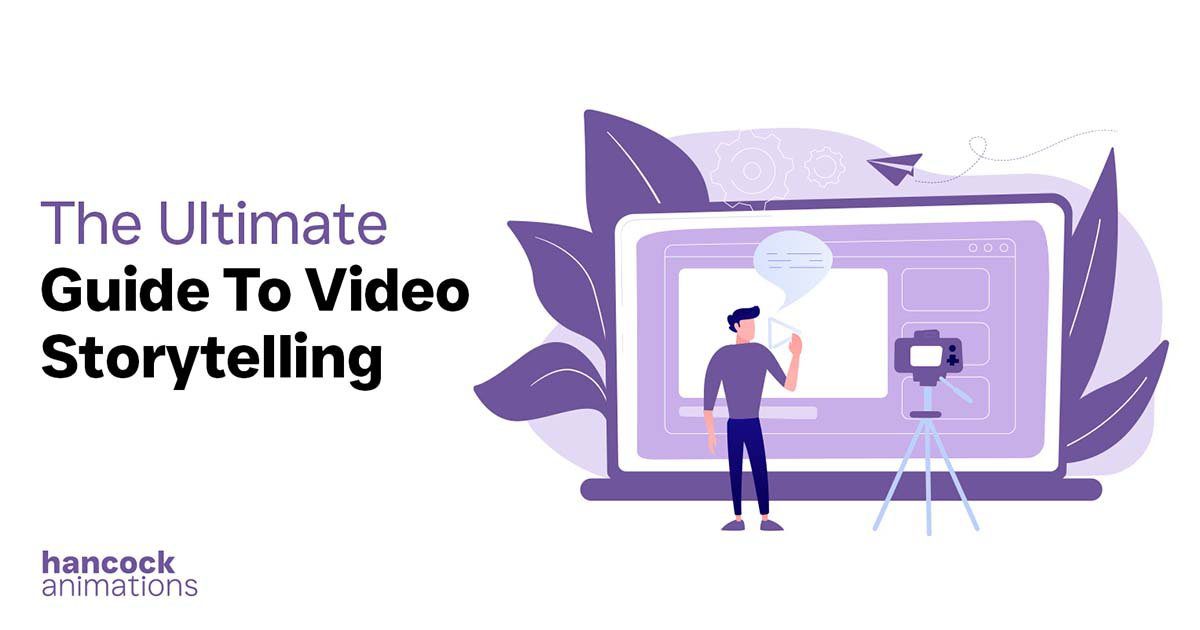The Ultimate Guide To Video Storytelling

In today’s fast-paced world full of information and choices, one truth remains unshaken, people have a great love for stories. They’re like magnets for our attention. That’s why some of the most famous brands aren’t always the ones with the best products and services. They’re the ones that tell the coolest stories.
Storytelling is about sharing information with a mix of real facts and interesting tales. Some stories are real, while others are spiced up with imagination, all to make a point that sticks with people.
Now, in 2023, it’s clear that storytelling, especially through videos, is crucial. In the digital age, where everyone’s glued to screens, video storytelling is the way to grab people’s hearts and minds.
At Hancock Animations, a leading video storytelling company, we get why telling a story about your products and brand matters. We know that, in a world flooded with information, being memorable is key.
To help you understand video storytelling better and how it can boost your business, we’ve put together an elaborate guide. So, get ready, because we’re about to take you on a journey through the world of visual storytelling.

What is Video Storytelling?
The art of using pictures and sounds to tell a story or get across an idea is what we call storytelling in videos. It is all about delivering a narrative with the help of moving pictures and sounds, sometimes adding words and special effects.
Video storytelling could be as basic as someone sharing a personal story on video or as elaborate as a big commercial or a movie.
The important thing about video storytelling is that it guides the viewer through a story, making them think, feel emotions, and ultimately understand a specific message or ending.
Reasons Behind The Popularity Of Video Storytelling
In recent years, video storytelling has increased in popularity. But why has it gained such immense importance? Below, let’s explore the reasons driving the widespread acclaim of video storytelling:
1. Visual Engagement
Humans are naturally attracted to visuals. The video combines various aspects like images, motion, and sound, providing a multisensory experience that interests the audiences more effectively than text or static images.
2. Emotional Impact
Video can convey emotions more effectively through facial expressions, tone of voice, music, and visuals. This emotional connection helps viewers relate to the content and remember it.
3. Storytelling Power
Visual storytelling allows for a better narrative. Videos make it easier to convey complex ideas, brand messages, and personal experiences. Stories are memorable and relatable, making them an ideal medium for communication.
4. Accessibility
High-speed internet and smartphones have made video content accessible to people around the world much easier. This accessibility has made video production and consumption extremely local, allowing for diverse voices and stories to be heard.
5. Social Media Dominance
Social media platforms prioritize video content over images and written content, rewarding creators with wider reach and engagement. Algorithms also favor video, making it a strategic choice for those seeking visibility.
6. Mobile-First World
As mobile device usage continues to grow, on-the-go consumers prefer video content. Short videos are easy to watch during travel, breaks, or while waiting in line at the store.
7. User-Generated Content
Platforms like YouTube, TikTok, and Instagram encourage users to create and share their videos. This user-generated content adds authenticity and diversity to the visual storytelling world.
8. Educational Value
A video is an effective tool for education and tutorials. It allows you to demonstrate a process, and enhance learning experiences in fields such as cooking, DIY, and education.
9. Brand Promotion
Brands have started to understand the power of visual storytelling for marketing and advertising. It allows them to showcase products, tell their brand’s story, and connect with consumers on a personal level.
10. Influencer Culture
Influencers provide video content services to engage with their followers authentically. This personal connection can influence purchasing decisions and build brand loyalty.
11. Virtual Events and Live Streaming
In today’s world, video is crucial for hosting virtual events, conferences, and live streams. It provides a platform for real-time engagement and interaction with a global audience.
12. Search Engine Optimization (SEO)
Search Engine favors video content, helping websites rank higher in search results. This drives organic traffic to your platform and increases visibility.
13. Measurable Results
Digital platforms offer robust analytics for video content, allowing creators and brands to keep track of engagement, reach, and ROI. This data-driven approach informs content strategists about what they are doing wrong and how they can improve their next video content.
14. Technological Advancement
Innovations like 4K video, virtual reality (VR), and augmented reality (AR) have expanded the creative possibilities of video storytelling, enabling immersive and interactive experiences for users.
15. Cultural Shift
Society has embraced video as a primary form of communication. From news updates to entertainment, people turn to video for information, entertainment, and connection.

Important Elements of Video Storytelling
Video storytelling, like any form of narrative storytelling, relies on various elements to create engaging and compelling content. Here are some key elements of video storytelling:
1. Character Development
Developing relatable and well-defined characters is extremely important for a good story. Viewers need to connect with the characters, whether they are real people in a documentary, fictional characters in a scripted film, or even the central figure in a brand’s story.
The audience should understand the characters’ motivations, challenges, and transformations over the course of the story.
2. Conflict
Conflict is at the heart of storytelling. It creates tension and takes the narrative forward. Whether it is a personal struggle, a clash of ideas, or an external obstacle, conflict helps the story go forward and keeps viewers engaged.
The resolution of this conflict often provides the story with an emotional payoff.
3. Plot
A well-structured plot outlines the sequence of events in your video.
It includes the introduction, rising action, climax, falling action, and resolution. A clear plot keeps the story organized and engaging. It also provides a subtle flow to the story
4. Setting
The setting of your video provides context and atmosphere. It includes the physical location, time period, and the cultural or social environment in which the story is taking place. The setting helps viewers understand the narrative better.
5. Theme
The theme is the central message or idea that the video conveys. It is the deeper meaning behind the story. Themes can be complex or straightforward, but they give the story depth and resonance.
For example, a documentary about environmental conservation might have a theme of responsibility and stewardship.
6. Narrative Structure
The structure of a story can vary but often includes elements like a beginning, middle, and end. In some cases, a video storytelling company uses non-linear storytelling techniques to create intrigue or highlight specific aspects of the narrative.
7. Visual and Auditory Elements
Video storytelling incorporates a range of visual and auditory elements, such as cinematography, lighting, sound design, music, and editing. These elements add to the mood, tone, and pacing of the story.
8. Conflict Resolution
Stories often come to a resolution where the storyteller addresses the conflicts and makes the loose ends meet. This resolution can be happy, sad, or bittersweet, depending on the story’s tone and message.
9. Voiceover or Dialogue
The words you speak are a powerful tool in visual storytelling. Whether it’s through narration, dialogue, or interviews, the spoken word helps convey information, emotions, and character development in a much better and more effective way.
10. Symbolism and Metaphor
Symbolic elements and metaphors can add depth and value to a story. Visual symbols or recurring motifs can represent abstract concepts or themes. They also add layers of meaning for viewers to interpret.

What Is The Process Of Video Storytelling?
For Hancock Animations, providing video storytelling services is a creative process that involves several key steps to come up with a compelling narrative through the medium of video. We have broken down the process into 5 major steps:
Conceptualization and Planning
Idea Generation
The process begins with brainstorming and coming up with ideas. What story do you want to tell, and what message or emotion do you want to convey?
Audience Analysis
Consider who your target audience is. Understanding their interests, preferences, and demographics will help design your story which the audience will resonate with.
Story Outline
Create a rough outline or script for your video. Outline the key plot points, characters, conflicts, and resolution. Determine the video’s structure, including the beginning, middle, and end.
Pre-production
Scriptwriting
If your video requires dialogue or narration, write a script that tells what characters will say or what the narrator will convey. To get your script written by professionals, you can hire creative scriptwriting services from Hancock Animations.
Storyboarding
Create a visual storyboard or shot list that outlines the sequence of shots and camera angles you plan to use. This helps with visualizing the narrative.
Casting
If your video includes actors or on-screen talent, cast them based on the characters you have defined.
Location Scouting
Find suitable filming locations that match the story’s setting and atmosphere.
Equipment and Crew
Gather the necessary video equipment, such as cameras, lighting, and sound equipment. Assemble a crew or hire a professional storytelling video production company like Hancock Animations, including directors, cinematographers, sound engineers, and production assistants.
Production
Filming
Shoot the planned shots and scenes according to the storyboard and script. Pay attention to lighting, framing, and sound quality during filming.
Direction
The director guides the actors and crew to ensure that the story is conveyed effectively and that the desired performances are achieved.
Continuity
Ensure continuity in scenes, such as maintaining consistent props, costumes, and character positioning.
Post-production
Editing
Storytelling video editing services involve selecting the best shots, arranging them in the desired order, and adding transitions. Editing also includes adding music, sound effects, and visual effects if necessary.
Color Correction
Adjust the color and tone of the video to achieve a cohesive and visually appealing look.
Sound Design
Enhance the audio quality by adding or adjusting sound effects, background music, and voiceovers.
Visual Effects in Video Stories
If your story requires special effects or CGI, this is the stage where they are incorporated.
Text and Titles
Add any necessary on-screen text or titles to provide context, captions, or additional information.
Review and Feedback
Seek feedback from team members or stakeholders and make necessary revisions to improve the video’s quality.
Distribution and Promotion
Platform Selection
Pick where and how you will distribute your video. Will it be on social media, your website, YouTube, or other platforms?
Audience Engagement
Use social media marketing, email campaigns, and other promotional efforts to engage your target audience and encourage them to watch the video.
Feedback and Analytics
Monitor audience engagement and gather feedback to evaluate the video’s impact and effectiveness.
Tips to Create Effective Storytelling Videos
1. Understand the preferences, interests, and demographics of your target audience. Tailor your story to resonate with them and address their needs or concerns.
2. Clearly define the central message or theme of your video. What do you want viewers to take away from it? Ensure that your message is concise and easy to understand.
3. Develop relatable and well-defined characters that viewers can connect with. Whether they are real people in a documentary or fictional characters in a narrative, make them relatable and interesting.
4. Every story needs conflict to create tension and drive the narrative forward. Show how characters overcome challenges or obstacles to reach a resolution or conclusion.
5. Use emotional storytelling to connect with viewers on a personal level. Touch on universal emotions like joy, sadness, fear, or hope to create empathy and engagement.
6. Pay attention to visual elements like framing, composition, and cinematography. Use visuals to convey emotions, set the mood, and enhance the storytelling.
7. Organize your video with a clear beginning, middle, and end. Hook the audience in the opening, build tension in the middle, and provide a satisfying resolution or conclusion.
8. Use visuals, actions, and expressions to convey information rather than relying solely on narration or dialogue. Visual storytelling is powerful and can transcend language barriers.
9. Music and sound in storytelling can enhance the emotional impact of your video. Choose music that complements the mood and pace of the story.
10. Maintain a balanced pacing throughout your video. Avoid rushing through scenes or dragging the story, as pacing influences viewer engagement.
Transform your message into a captivating story.
Reach out to explore Hancock Animations’ video storytelling services.
Key elements include well-defined characters, conflict and resolution, a clear message or theme, emotional engagement, and effective use of visuals and audio.
Planning involves concept development, scriptwriting, storyboarding, casting, location scouting, equipment acquisition, and a detailed production schedule.
Storytelling can enhance a wide range of videos, including documentaries, short films, advertisements, brand stories, educational content, and social media videos.
Understanding the target audience helps tailor the story to their interests and preferences, increasing the likelihood of engagement and resonance.

